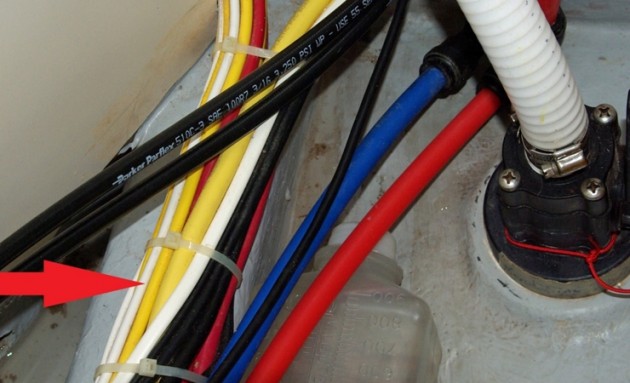Is My Boat Wiring Going to Overheat?
If you measure with a thermometer, you'll probably find that those wires aren't as hot as you think.
June 20, 2014
Question: The photo I sent in shows a bundle of wiring on my newly purchased boat. The picture really doesn’t do justice to the situation I’m worried about, and that is wire overheating.

Despite the large wiring bundle, there's not much chance of the bundle overheating when carrying normal electrical loads.
The compartment shown is directly adjacent to my engine compartment and after running for a while it gets really hot inside the compartment. I know that there are temperature rating rules for wire and cable but I’m not up on the details. Can you provide some guidance here?
Answer: That’s a good question and one that we wish more people were concerned over. You are quite right that the ABYC in its E-11 standard does have a series of tables for properly sizing wire and cables based on the amount of amperage they are expected to carry. The way in which cables get sized works quite differently between AC (shore power) and low-voltage DC cables. The bundle in your photo (marked with a red arrow) looks to me like a mix of both, so that complicates things a little bit.
For AC bundles, the larger the bundle the more current-carrying conductors it has. That will equate to a lower theoretical “ampacity” that each cable is expected to conduct. This is also based on the wire and cable insulation temperature rating, which should be printed on the insulation jacket. Common here in the US is 105°C or 221°F. For DC cable we are concerned about temperature as well, but we’re actually more concerned about voltage drop due to the comparatively low voltage we start out with, nominally 12 or sometimes 24 volts. So, for DC cable runs we increase the size of the wire based on the distance the cable has to travel through the boat, and again, proportional to the amount of amperage the cable is expected to conduct at a given voltage.
Another consideration in all of this is whether the cables in the bundle are carrying current continuously or on an intermittent basis. In the case of large DC conductors, the loads are generally intermittent ,so we tend to discount them in terms of any heat generation. About the only exception to this might be DC power feeds to a DC-to-AC inverter, in which case the cables might be carrying considerable current for some time, depending upon what AC loads the inverter is supplying.
To answer your question directly, get a thermometer, leave it in the space you’re worried about, and get things warmed up to the normal temperature. I’ll bet the cables themselves are getting nowhere near that 220°F danger zone. In spite of the multitude of wires in your photo there is actually air circulating around the bundle, which will help to keep it reasonably cool even in proximity to the hot engine room space. If the bundle were inside a conduit, things might be different, but in your case I wouldn’t worry. Again, just check with a thermometer.
Editor's note: For more detail on this and other marine electrical issues, read Ed Sherman's book, The Power Boater’s Guide to Electrical Systems. (It applies equally to sailboats, since electricity really has no idea where it is.)












